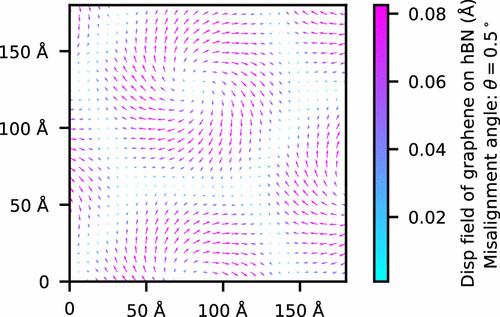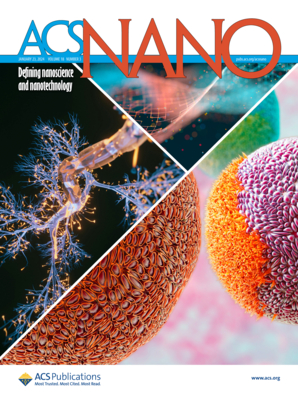Adhesion and Reconstruction of Graphene/Hexagonal Boron Nitride Heterostructures: A Quantum Monte Carlo Study
IF 15.8
1区 材料科学
Q1 CHEMISTRY, MULTIDISCIPLINARY
引用次数: 0
Abstract
We investigate interlayer adhesion and relaxation at interfaces between graphene and hexagonal boron nitride (hBN) monolayers in van der Waals heterostructures. The adhesion potential between graphene and hBN is calculated as a function of local lattice offset using diffusion quantum Monte Carlo methods, which provide an accurate treatment of van der Waals interactions. Combining the adhesion potential with elasticity theory, we determined the relaxed structures of graphene and hBN layers at interfaces, finding no metastable structures. The adhesion potential is well described by simple Lennard–Jones pair potentials that we parametrize using our quantum Monte Carlo data. Encapsulation of graphene between near-aligned crystals of hBN gives rise to a moiré pattern whose period is determined by the misalignment angle between the hBN crystals superimposed over the moiré superlattice previously studied in graphene on an hBN substrate. We model minibands in such supermoiré superlattices and find them to be sensitive to the 180° rotation of one of the encapsulating hBN crystals. We find that monolayer and bilayer graphene placed on a bulk hBN substrate and bulk hBN/graphene/bulk hBN systems do not relax to adopt a common lattice constant. The energetic balance is much closer for free-standing monolayer graphene/hBN bilayers and hBN/graphene/hBN trilayers. The layers in an alternating stack of graphene and hBN are predicted to strain to adopt a common lattice constant, and hence, we obtain a stable three-dimensional crystal with a distinct electronic structure.

求助全文
约1分钟内获得全文
求助全文
来源期刊

ACS Nano
工程技术-材料科学:综合
CiteScore
26.00
自引率
4.10%
发文量
1627
审稿时长
1.7 months
期刊介绍:
ACS Nano, published monthly, serves as an international forum for comprehensive articles on nanoscience and nanotechnology research at the intersections of chemistry, biology, materials science, physics, and engineering. The journal fosters communication among scientists in these communities, facilitating collaboration, new research opportunities, and advancements through discoveries. ACS Nano covers synthesis, assembly, characterization, theory, and simulation of nanostructures, nanobiotechnology, nanofabrication, methods and tools for nanoscience and nanotechnology, and self- and directed-assembly. Alongside original research articles, it offers thorough reviews, perspectives on cutting-edge research, and discussions envisioning the future of nanoscience and nanotechnology.
 求助内容:
求助内容: 应助结果提醒方式:
应助结果提醒方式:


